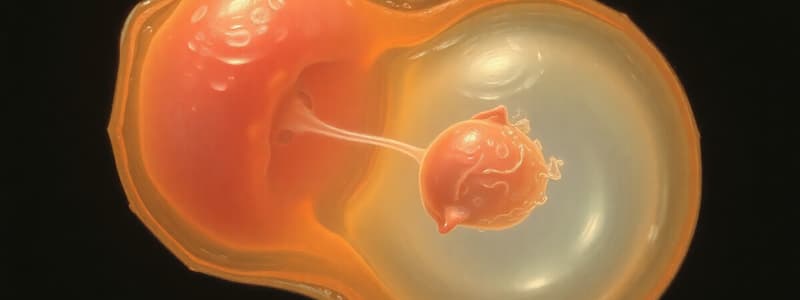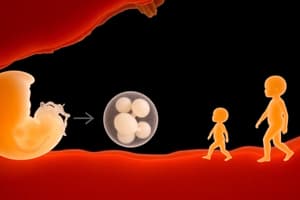Podcast
Questions and Answers
Where does fertilization typically occur?
Where does fertilization typically occur?
- Ovary
- Ampullary part of the fallopian tubes (correct)
- Uterus
- Cervix
What is the name given to the fluid contained in the amniotic sac?
What is the name given to the fluid contained in the amniotic sac?
- Follicular fluid
- Vitelline fluid
- Seminal fluid
- Amniotic fluid (correct)
What is the term for a lower-than-normal amount of amniotic fluid?
What is the term for a lower-than-normal amount of amniotic fluid?
- Normohydramnios
- Hyperhydramnios
- Anhydramnios
- Oligohydramnios (correct)
What is the definition of fertilization?
What is the definition of fertilization?
Which of the following is a prerequisite for conception?
Which of the following is a prerequisite for conception?
What is the name for the resulting fertilized ovum?
What is the name for the resulting fertilized ovum?
What process restores the diploid number of chromosomes?
What process restores the diploid number of chromosomes?
How long does an ovum remain fertile after ovulation?
How long does an ovum remain fertile after ovulation?
What does an XX zygote typically develop into?
What does an XX zygote typically develop into?
What is the rapid division of cells in the zygote called?
What is the rapid division of cells in the zygote called?
Approximately how many days after fertilization does the zygote reach the uterus?
Approximately how many days after fertilization does the zygote reach the uterus?
What is the solid ball of 16 cells formed during early cell division called?
What is the solid ball of 16 cells formed during early cell division called?
Which structure develops from the outer cell mass of the blastocyst?
Which structure develops from the outer cell mass of the blastocyst?
Around what day after fertilization does implantation typically begin?
Around what day after fertilization does implantation typically begin?
What is the endometrium called after implantation?
What is the endometrium called after implantation?
Which germ layer primarily forms the skin and nervous system?
Which germ layer primarily forms the skin and nervous system?
Flashcards
Sex Determination
Sex Determination
XX zygote develops into a female, while an XY zygote develops into a male.
Cleavage (Embryonic)
Cleavage (Embryonic)
Rapid cell division of the zygote after fertilization.
Morula
Morula
A solid ball of 16 cells formed during cleavage.
Blastocyst
Blastocyst
Signup and view all the flashcards
Trophoblast
Trophoblast
Signup and view all the flashcards
Embryoblast
Embryoblast
Signup and view all the flashcards
Implantation
Implantation
Signup and view all the flashcards
Decidua
Decidua
Signup and view all the flashcards
Amniotic Fluid
Amniotic Fluid
Signup and view all the flashcards
Oligohydramnios
Oligohydramnios
Signup and view all the flashcards
Polyhydramnios
Polyhydramnios
Signup and view all the flashcards
Fertilization
Fertilization
Signup and view all the flashcards
Prerequisites for Conception
Prerequisites for Conception
Signup and view all the flashcards
Process of Conception
Process of Conception
Signup and view all the flashcards
Sperm and Ovum Viability
Sperm and Ovum Viability
Signup and view all the flashcards
Zygote Formation
Zygote Formation
Signup and view all the flashcards
Study Notes
- Every human cell contains 23 pairs of homologous chromosomes, with the exception of the ovum and sperm.
- Ovum and sperm contain 22 pairs of somatic chromosomes and 1 pair of sex chromosomes each.
- In females, the sex chromosomes are XX, while in males, sperm can carry either an X or a Y chromosome.
Key Definitions
- Amniotic fluid is contained within the amniotic sac, also known as liquor amnii or "waters."
- Amniotic fluid is transparent or slightly yellow, protecting the fetus from trauma, maintaining body temperature, and serving as a source of oral fluid and waste repository.
- Oligo-hydramnios refers to a lower-than-normal amount of amniotic fluid.
- Polyhydramnios refers to a higher-than-normal amount of amniotic fluid.
Fertilization Basics
- Fertilization is defined as the union of a sperm with an ovum, occurring in the ampullary part of the fallopian tube.
Prerequisites for Conception:
- A mature ovum is needed for conception.
- Mature spermatozoa must be present.
- Spermatozoa must undergo capacitation and an acrosome reaction.
- Adequate quality and quantity of spermatozoa are required.
- Sperm and ovum must meet within 24 hours.
Process of Conception:
- Fertilization must occur.
- Divisions (cleavages) must occur
- Implantation needs to take place
- Development and formation of the placenta are essential.
How Fertilization Works
- Each month, one ovum matures and remains fertile for about 24 hours after ovulation, remaining viable for about 48 hours.
- Ejaculated semen contains more than 100 million sperm per milliliter.
- Sperm swim with flagellar movements of their tails, some reaching the ovum within 5 minutes and remaining viable for about 2-3 days.
- Only one sperm is able to enter an ovum to fertilize it.
- During fertilization, the nucleus from the ovum and the nucleus of the sperm make contact.
- This union restores the diploid number (46) of chromosomes, creating a fertilized ovum called a zygote.
- The sex of the fetus depends on whether the ovum is fertilized by a Y-bearing sperm (resulting in a male) or an X-bearing sperm (resulting in a female).
- An XX zygote results in a female and XY zygote gives a male
Cleavage Details
- Cleavage is the rapid division of cells that happens in the zygote after fertilization.
- The zygote passes through the fallopian tube and reaches the uterus about three days later.
- On its way to the uterine cavity, the zygote undergoes cell division (mitosis), dividing into 2, 4, 8, and then 16 cells.
- The 16-cell stage appears as a solid ball of cells called a morula.
- Within the morula, a fluid-filled space appears, transforming it into a hollow ball of cells called a blastocyst.
- The fluid-filled cavity pushes some of the cells to one side, forming two layers;
- The outer cells mass (trophoblast) becomes the placenta
- The inner cell mass (embryoblast) becomes the fetus.
Implantation Facts
- The blastocyst is at the stage at which it embeds (implants).
- Around the 7th day after fertilization or conception, the blastocyst settles in the endometrium to begin implantation.
- The endometrium after implantation is called the decidua.
Decidua Layers
- The decidua can be differentiated into three layers after implantation.
- Decidua basalis is the area under embedded ovum.
- Decidua capsularis lies over the developing ovum.
- Decidua vera, or true deciduas, is the remainder of the uterus.
- After implantation, cell differentiation begins within the inner cell mass.
- One cavity becomes the yolk sac, which provides nourishment for the developing embryo for a brief time and then disappears.
- Another cavity becomes the amniotic sac, containing fluid that later becomes amniotic fluid.
Embryonic area organization of germ cells
- Ectoderm mainly forms the skin, mucosa, and nervous system.
- Mesoderm forms bones, muscles, and heart blood vessels.
- Endoderm forms mucous membranes, glands, and epithelium of the liver, pancreas, lungs, and bladder.
Placenta Formation
- Three weeks after fertilization, projections from the trophoblastic layer proliferate and branch, forming the chorionic villi.
- The villi become most profuse in the basal decidua, where the blood supply is richest.
- This part is known as the chorion frondosum and develops into the placenta.
- The placenta is completely formed and functioning about 12 weeks after fertilization.
Studying That Suits You
Use AI to generate personalized quizzes and flashcards to suit your learning preferences.




